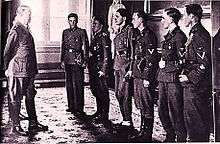Sophus Kahrs
| Sophus Magdalon Buck Kahrs | |
|---|---|
 Sophus Kahrs with Vidkun Quisling | |
| Born |
28 March 1918 Bergen, Norway |
| Died |
18 November 1986 (aged 68) Buenos Aires, Argentina |
| Allegiance |
|
| Service/branch |
|
| Years of service | World War II 1936–1944 |
| Rank | Sturmbannführer |
| Unit |
SS-Freiwilligen-Legion Norwegen SS Ski Jäger Battalion "Norwegen" Førergarden |
| Battles/wars |
Siege of Leningrad Vyborg–Petrozavodsk Offensive |
| Awards |
World War II Iron Cross I Class |
Sophus Magdalon Buck Kahrs (28 March 1918 – 18 November 1986) was a Sturmbannfuhrer (Major) in the Waffen SS during World War II. He was awarded the Iron Cross of the I class, which was awarded to recognize battlefield bravery during World War II. He served as the battalion commander of the SS Ski Jäger Battalion "Norwegen", seeing action in Finland in 1944, and later in Norway in 1945.
Kahrs was born in Bergen, Norway in 1918 into a family of German origins. He joined the Nasjonal Samling in 1934. And around the same time he also joined the party's paramilitary wing, the Hird, and from 1936 the NS Battle Organization.[1] After the outbreak of World War II, he joined the Waffen-SS. He served with the Norwegian volunteer unit SS-Freiwilligen-Legion Norwegen at the Siege of Leningrad. In the summer of 1944 made acting battalion commander of the SS Ski Jäger Battalion "Norwegen".
In 2013 Norwegian daily Dagbladet's then correspondent in Germany said that "The Norwegian company commander failed—and fled the combat zone, while many were killed or captured".[2] Kahrs disappeared early in the battle—later reappearing uninjured in the rear echelons, where he in his own report put himself in a positive light; thus avoiding court martial. Later he was put in charge of Vidkun Quislings bodyguard detail, known as the Førergarde.
After the war, Kahrs was arrested and charged with treason. He was convicted and sentenced to 10 years of hard labour, and 19 years in prison. He escaped on 3 July 1947, along with three other inmates, from Espeland concentration camp. They soon joined up with three other former SS members and sailed on the boat Solbris to Buenos Aires, Argentina. He was joined by his wife and son.[3] He found work as an electrician, and later as a foreman at an American car company, until his death on 18 November 1986.[4] His son returned to Bergen in 2005, a year later, he died.[5]
References
- ↑ Brøymer, Bjørn (19 March 1988). "En NS røst fra Argentina". Bergens tidende: 9.
- ↑ Asbjørn Svarstad (2013-09-29). "Norske SS-soldater kokte russerkranier" [Norwegian SS soldiers boiled Russian skulls]. Dagbladet. p. 34.
Den norske kompanisjefen sviktet og stakk av fra kampsonen, mens mange ble drept eller tatt til fange og andre måtte kjempe seg dager og uker gjennom den rå naturen, før de til slutt nådde tilbake til folk.
- ↑ "Bergens tidende gjenopplever". Folk og land: 7. May 1978.
- ↑ Bjerkestrand, Frode (5 May 1995). "Arved etter Solbris". Bergens Tidende: 14.
- ↑ Svendsen, Roy. "Kom hjem etter 55 år". Nettavisen.no (in Norwegian). Retrieved 10 August 2013.